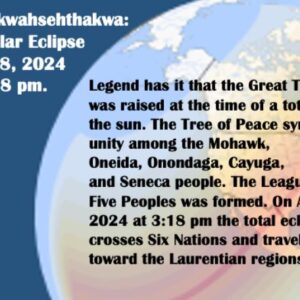
The release of the final report of the Missing and Murdered Indigenous Women and Girls (MMIWG) Inquiry has unleashed opposing views hijacked by the use of the term genocide.
What is in the word genocide? Is the harm only contained in the carefully crafted and acceptable parameters found within mainstream whiteman made legal terms?
Or can we define genocide as what we think of, immediately – the killing of a people.
Genocide does not have to be viewed in the compartmentalized blinder-on fashion suggested by mainstream Canada. It can actually be seen in the history of the marginalization of Indigenous people in Canada – with specific attention to women.
When the original settlers came to this land, did they bring women? Did the European settlers bring with them an understanding of the role of women? Well, the first settlers certainly were not women, and there are no reports of women accompanying Columbus et al. This is probably because in fifteenth century Europe, there was a clear understanding of the role of women.
Women, in the settlers’ world, were inferior. Women were unable to inherit or own property. In fact women were considered to be the property of their husbands. The first colonists arrived with this stereotypical view of women when they stumbled onto the territory now called Canada.
Imagine the early settler surprise! They came upon a land of thriving people who were tall, healthy, spiritual, organized and where the role of women balanced the men for Indigenous people. Early settlers had no way of understanding that leadership could be found in highly complex systems that included matriarchal powers or the spiritual guidance of powerful medicine women. The early settlers saw camps where men came forward because then, Indigenous men went first to protect the children, the women, the elders and their way of life.
With the strength of our Indigenous men clearly visible, first settler colonizers assumed that these powerful warriors ruled by force, with individualistic agendas. The early colonizers had no idea that leadership could be vested in the role of women. The early settlers could not see a society where grandmothers selected leadership. Early settler white males did not understand that our women owned the teepee, home or living structure.
Canadian systems have evolved based on primarily white male-driven institutions from their countries of origin. With this background, did the original settlers or their subsequent governments understand that the Indigenous systems were functioning differently?
Countless reports, inquiries, studies and other works have been done with a colonial lens to understand “the Indian problem.” However, if there is a premise or threshold argument grounded in a white male paternalistic thinking, how can this approach ever solve problems where women are an integral part of the system? We must consider this carefully since evidence points to these very processes, institutions, and approaches as being the actual problem. We know that colonial policies of Indian removal, starvation and subjugation are the root behind current Indigenous-inherited poverty and trauma. But if you listen carefully to the narrative in mainstream media covering the MMIWG report, this clash of viewpoints is not newsworthy.
We have entered into a debate of what currently constitutes “genocide”. Countless white male voices are asserting that “things may have happened in the past” but the definition of genocide remains the outright killing of individuals. Media talking heads are trying to downplay the term by calling the treatment of Indigenous women, a tragedy or “its own thing,” instead of recognizing it as a violation of human rights.
So let’s look at this definition of genocide. Are First Nations currently fighting on the front lines or in courts to defend the last pieces of their lands, waters and territories from whiteman made encroachment through development? Yes. Do these First Nations have histories of tainted water, higher rates of cancer or mercury poisoning and hampered access to traditional or culturally relevant foods and plants? Yes. Do Canada’s own statistics reflect higher Indigenous suicides and lower Indigenous living standards? Yes. If you look through an Indigenous lens at the policies, legislations, court decisions, and institutions that dictate the lives of the Indigenous people on their own lands, you will see active, prolonged instruments of genocide applied everyday.
Is it genocide to remove children from homes breaking the kinship, parenting and educations system that had existed pre-contact, while inflicting mental trauma and abuse both sexual and physical? Yes. Was it genocide to use germ warfare with smallpox blankets to obliterate a people who were blocking settler access in the west? Yes.
Is it genocide to have used native children for nutrition experiments, or subjected these same children to electric chairs in residential schools? Is it a genocidal action to sterilize women? Yes. Are these collective policies so ancient that today, the Indigenous have no living memory of these attacks? No.
The Indigenous people carry the blood memory, words in our languages and the knowledge through oral history of these acts to kill our people. It is because of this lived experience that we understand the intent within similar policies or legislations that will continue this obliteration of who we are as Indigenous peoples.
Evidence of crimes against Indigenous humanity happened because the initial settlers followed the doctrine of discovery thinking. They did not see the beauty in the women who held the backbone of each of our camps in place. They did not see the long line of grandmothers, who doctored, taught and guided the community back to the Creation stories. They did not see the women who were warriors or the acceptance of LGBQT2 people in Indigenous societies.
This has been the genocide. In a country where white men make the laws, interpret and apply the laws; can they see they have destroyed the Indigenous women’s role and voice in true indigenous governance and self-determining systems? Can they see that the very nature of their whiteman made systems have killed the equality of women in our Indigenous societies? If whitemen cannot acknowledge the worth and equality of white women; is it then willful blindness that prevents them from seeing, understanding or accepting that First Nations elevated their women recognizing their inherent power?
Has there ever been a true understanding of the Indigenous nations that existed pre-colonization? If there is no true understanding, then there is no reconciliation. Canadians can learn from Indigenous systems that recognized the power of the women. Canada’s white patriarchy will not discuss threats to power and control. Instead, they build systems that continue to undermine, marginalize and kill Indigenous women. That is genocide.







